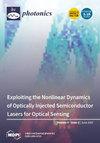导弹携带式脉冲激光前向探测系统高速飞行时的空气动力环境模拟测试
IF 2.1
4区 物理与天体物理
Q2 OPTICS
引用次数: 0
摘要
当导弹搭载的脉冲激光前向探测系统以超音速飞行时,激光束会因不均匀的外流场而发生扭曲,导致测距精度大大降低。本文研究了高速飞行对脉冲激光探测系统的影响。首先,提出了一种自适应步长调整的新射线跟踪方法,大大提高了计算效率。其次,通过间歇式跨音速和超音速风洞模拟弹药高速飞行时的气动环境,获得不同马赫数下的流场离层数据。Schlieren 数据显示了与模拟结果类似的冲击波结构。此外,还研究了模型在不同气动条件下脉冲激光回波波形的变化规律,以评估激光探测系统在静态条件下的可探测性和运行稳定性。测试结果与仿真结果吻合良好,两者的冲击波结构相对一致,验证了流场仿真模型的正确性和有效性。测试回波波形与模拟回波波形吻合良好;在不同马赫数下,测试回波波形与模拟回波波形峰值之间的相对误差不超过 20%,测试回波波形与模拟回波波形之间的相关系数均超过 0.7,表明两者之间具有很高的相关性。本文章由计算机程序翻译,如有差异,请以英文原文为准。
Simulation Test of The Aerodynamic Environment of A Missile-Borne Pulsed Laser Forward Detection System at High Flight Speed
When a missile-borne pulsed laser forward detection system flies at supersonic speed, the laser beam will be distorted by the uneven outflow field, resulting in a significant reduction in ranging accuracy. In this paper, the impact of high flight speed on a pulsed laser detection system is studied. First, a new ray tracing method with adaptive step size adjustment is proposed, which greatly improves the computational efficiency. Second, the aerodynamic environment of a munition flying at high speed is simulated by an intermittent transonic and supersonic wind tunnel to obtain the schlieren data of the flow field at various Mach numbers. The schlieren data present a shock wave structure similar to that of the simulation. In addition, the variation patterns of the pulsed laser echo waveform of the model under different aerodynamic conditions are studied to evaluate the detectability and operational stability of the laser detection system under static conditions. The test results match the simulation results well, and the two offer relatively consistent shock wave structures, which verifies the correctness and effectiveness of the flow field simulation model. The test echo waveforms are in good agreement with the simulated echo waveforms; the relative errors between the peak values of test and simulated echo waveforms at various Mach numbers do not exceed 20%, and the correlation coefficients between the test and simulated echo waveforms all exceed 0.7, indicating high correlations between the two.
求助全文
通过发布文献求助,成功后即可免费获取论文全文。
去求助
来源期刊

Photonics
Physics and Astronomy-Instrumentation
CiteScore
2.60
自引率
20.80%
发文量
817
审稿时长
8 weeks
期刊介绍:
Photonics (ISSN 2304-6732) aims at a fast turn around time for peer-reviewing manuscripts and producing accepted articles. The online-only and open access nature of the journal will allow for a speedy and wide circulation of your research as well as review articles. We aim at establishing Photonics as a leading venue for publishing high impact fundamental research but also applications of optics and photonics. The journal particularly welcomes both theoretical (simulation) and experimental research. Our aim is to encourage scientists to publish their experimental and theoretical results in as much detail as possible. There is no restriction on the length of the papers. The full experimental details must be provided so that the results can be reproduced. Electronic files and software regarding the full details of the calculation and experimental procedure, if unable to be published in a normal way, can be deposited as supplementary material.
 求助内容:
求助内容: 应助结果提醒方式:
应助结果提醒方式:


